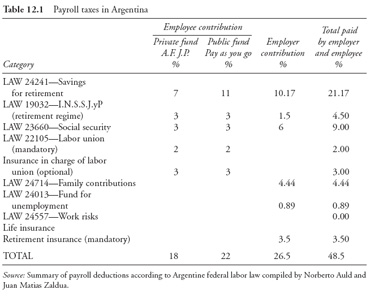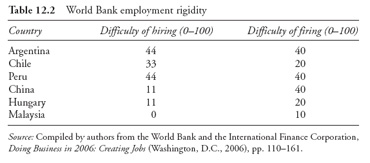Labor Reform: Undercompetitive Economies and Unprotected Workforce
Labor Reform: Undercompetitive Economies and Unprotected Workforce
Senior Policy Director and Americas Quarterly Editor-in-Chief Christopher Sabatini examines why Latin America remains one of the most inflexible regions in terms of labor markets. He suggests swift labor law reforms to attract foreign investment, increase productivity, and social protections for their workforce.
It is difficult to imagine a more dysfunctional labor situation than what currently exists in Latin America. Costs for hiring new employees and firing unnecessary ones make Latin America one of the most inflexible labor markets in the world, throttling the private sector’s capacity to increase productiveness and discouraging new investment. On the labor side, the laws have done little good as well. Constraints on formally hiring new employees have dampened employment growth, increasing the ranks of the jobless and those employed outside the law. These informal workers, who represent close to half of the region’s workforce, exist on the margins of the economy and society, often with few legal and social protections.
In this environment it is no exaggeration to say that almost everyone loses: employers, employees, and the region’s competitiveness in general. To argue for reform in this dysfunctional deadlock of labor regulations does not imply a rejection of labor rights or the removal of all benefits. Unarguably, the current arrangement has failed workers, particularly those now in the informal sector. In contrast to the relatively narrow areas of trade, tax, and fiscal reform, labor reform, for historical and institutional reasons, is a far more political nut to crack. But the effect of labor law on regional competitiveness and the growing numbers of informal sector workers has opened an innovative path for resolving this collective action problem.
This chapter provides a brief overview of employment trends after the economic reforms of the 1990s and then looks deeper at the current state of labor laws in the region, focusing specifically on examples in
Reforms and Employment
According to regionwide surveys, unemployment and job security remain the number one concern of Latin American citizens today, and with good reason. Unemployment rates in
Bank (IDB) concluded that approximately 113,000 people lost their jobs as onetime public holdings passed into private hands.2 In addition, modernization of the public sector throughout the region produced thousands of layoffs, as governments struggled to reduce fiscal expenditures by reducing their bloated public sectors. The same IDB study of
The assumptions of those backing these reforms were that the workers who bore the brunt of the adjustment would quickly be reabsorbed in other areas of the economy. The expectation was that by addressing fundamental inefficiencies in the macroeconomic environment, reforms would create a more competitive economy that could induce economic growth and ultimately increase labor demand. Further, it was believed that the integration of Latin American economies into the global market would favor the region’s advantages of cheap labor and lead to greater demand for unskilled labor.
While the uneven levels of economic growth that followed did help to create new jobs, the growth was insufficient to sop up the increase in the labor force resulting from the public and private sector layoffs and the entrance of new workers into the labor market. The unanticipated “jobless growth” produced regional urban unemployment rates from 1990 to 2004 that grew by 37 percent from 7.3 percent to 10 percent, with rates in countries such as Argentina, Brazil, and Ecuador more than doubling in that period. And in stark contradiction to conventional wisdom, those most affected by the downturn in employment were unskilled and semiskilled workers and youth. Throughout the region trade actually increased wage disparities between skilled workers (who benefited from the growth of export and service sector jobs) and unskilled and semiskilled workers (many of whom lost jobs in the restructuring). Sadly many unskilled workers who bore the brunt of adjustments were doubly affected: not only did they lose jobs, but they also lost many of the welfare benefits that the state and labor unions had typically provided for them.
But more important was the quality of the jobs generated during the period.
Throughout the region, the 1990s continued the trends of the 1980s: a contraction of employment in manufacturing and the public sectors, the expansion of employment in services, and the dramatic growth of employment in the informal sector. According to a 2005 International Labour Organization (ILO) report, during the 1990s, the number of jobs in the informal sector increased by 3.9 percent per year, compared with 2.1 percent growth in the formal sector.4
The persistence of unemployment and informal sector employment was largely consequence of finished reforms to labor markets. In the post–Washington
Consensus environment, in which the public sector no longer provided the primary source of employment and the state no longer coddled industries, firms that had to compete internationally had to increase productivity. Doing so meant reducing labor costs, but without changes to the hidebound labor codes that characterize
In every country in
Despite a series of reforms in the 1990s, and more recently in
In the case of

In
Chilean labor laws provide for one month’s salary, plus vacation multiplied by the number of years worked, up to 10 years.
In the 1990s, a number of countries tinkered with these laws. Most of these changes centered on allowing firms to contract temporary workers formally.
But these reforms were a palliative—a halfway measure by governments to address the problem of business demand for greater labor flexibility without having to face the political opposition implied in a broader reform of labor legislation. In this, the reforms failed on two fronts. First, by only permitting for temporary employment, they left untouched the larger issue of the cost associated with hiring permanent employees, the root problem of the labor market. Second, by creating a back door for hiring, the laws reduced the rights of workers, limiting their access to the benefits of full employment and undercutting their ability to organize.

The stalled state of labor reform, despite being on the agenda of multilateral banks, such as the World Bank and the IDB, is largely a story of political opposition and the traditional volatility of Latin American markets that favor social guarantees and protections. Many of the unions in
Apart from the political factors, however, the historical macroeconomic volatility that has marked Latin American economies has tended to favor greater reliance on legal guarantees for social and economic security. Legal disincentives to firing and strong contributions for social programs provided an important cushion against the wild fluctuations of Latin American economies. Job security provisions, in particular, served as a brake on the affect on employment of sharp, unexpected busts, while social protections and insurance guaranteed that the benefits of the boom were shared more broadly.
In this vein, as the pool of the underemployed and unemployed swelled after the economic reforms of the 1990s, political momentum for reforms that would diminish benefits and guarantees of the remaining (organized) workers came to a grinding halt. A reform of labor code, ironically, would ultimately have benefited those who had lost their jobs; unfortunately, in the classic collective action problem, those who could have benefited were not organized or as politically powerful as those who had retained their employment and its organizational and political perquisites. The result, unfortunately, was the kicking down the road of a key reform, with the economic, social and political costs it would bring.
Employment Rigidity and Informality8
Businesses must, of course, take into careful account the long-term legal and financial costs and commitments associated with hiring new regular employees. The high incidence of job-security provisions serves as a disincentive to reducing unproductive laborers or shifting them to other areas. At the same time, the risk of being saddled with expensive, hard-to-fire workers discourages firms from engaging in new hiring. The result, more often than not, has been for expanding businesses to seek extralegal means for contracting employees. Recently, a series of studies has attempted to measure the cost of job-security provisions to labor demand, patterns of unemployment, and the growth of the informal sector.
While many of these studies are still single country in nature, what they have found is that the effect of reducing the costs of firing or dismissing employees is threefold.9 First, while reducing the costs to firing employees increases the turnover rate in the formal sector, it is also associated with a decline in the overall unemployment rate. Basically, firms can formally shed workers more efficiently—and do—but the reduction in firing costs also permits firms to hire formally; thus the absorption rate in the formal sector increases, though often with a lag.
Second, studies have also found that high barriers to the dismissal of workers are associated with high rates of self-employment and informality. While the correlation is not perfect, research shows a correlation between labor regulations and job security provisions and informality.10 The reasons are obvious. The high risk of hiring employees formally increases the incentives for workers to avoid those costs by hiring outside the law in the informal sector.
Third, studies have shown that high job-security provisions segment the labor market and have highly discriminatory effects on youth, women, and unskilled workers. By creating an expensive disincentive for firing existing employees, particularly ones that have been in the job for a while (because of the years-at-work multiplier) job security provisions lock in older workers, and discriminate against the employment of new entrants into the workforce, primarily youth and women. According to one study, the effect of job-security provisions is twice as great on youth as it is on other sectors.11
Of course not all of the factors affecting firms’ decision to hire informally are shaped by costs of hiring and firing implied in labor law. In addition, to avoid the financial and administrative costs associated with formal, full-time employees, there is also a more intangible benefit to firms for hiring informally. Hiring formally brings the risk that regular employees will be more likely to organize or join unions that can later press for higher pay and benefits. Informal workers are not only cheaper; they are also a more quiescent labor force. Yet the very precariousness of informally contracted labor may arguably dampen productivity in the long run, making it less obviously a good bargain for employers or society as a whole.
Nevertheless, informal employment is a two-way street, with both firms and workers calculating costs and making choices. Research also suggests that the border between formal and informal employment is fairly porous and more voluntary than previously thought.12 Workers sometimes opt for the informal sector to avoid having to direct some of their salary to benefit plans. The decision is often based on both the low level of formal wages and a lack of confidence that benefits, such as pensions and unemployment insurance, will ever materialize in countries where employers can refuse to pay while governments drag their feet in making them. Rather than pay part of their salary into a system with few guarantees that they can collect their contribution and the expected match between the contribution and collection, many—logically—just prefer to be paid directly in cash.
Whether because of workers’ lack of other options or by their choice, the ranks of the informal sector have swelled over the last two decades. According to a 2005
ILO report, during the 1990s the rate of job growth in Latin America’s informal sector was almost twice that in the formal economy.13 While estimates vary depending on how “informal” employment is defined, most current studies calculate that close to half of Latin America’s nonagricultural workforce is now informal.14 In countries such as Ecuador, Honduras, and Peru that number is probably closer to 60 percent, while in Chile—whose rate of informality is the region’s lowest—just under 40 percent of nonagricultural workers are not formally employed.
While informal employment may have helped to cushion the blow of economic reforms in the absence of a more efficient labor market, it is hardly a desirable employment outcome. There is a fair amount of variation in how people enter the informal sector and the degree of choice in doing so. Yet, there can be little doubt that informal-sector employment is, on the whole, a suboptimal situation for a worker. Those who toil on the fringes of the formal economy all too often have limited access even to minimal job security or basic benefits and safety protections.
Frequently women and youth suffer most. According to a number of studies, women and younger workers make up the majority of those employed informally.15 That women and youth should be overrepresented in the informal sector is to be expected given the proven discriminatory effect that existing labor law has on aspiring entrants to the labor market. This effect looms particularly large in a region where more than a third of the populace is under 16.16 This “youth bubble” will mean that Latin American labor markets will have to absorb a flood of new workers when already, according to the ILO, unemployment among youth (18.8 percent) is more than double the overall unemployment rate of 9 percent.17
Unionization
The effect of the reduction of employment in public and manufacturing sectors that followed the economic reforms of the 1990s, the increased use of temporary work contracts, and the dramatic increase in the informal sector have meant plummeting rates of unionization throughout Latin America. As a result, unions find their traditional structures and orientations under pressure as never before.
The large public sectors and protected industries on which union organizers and leaders once focused gave way during the decade of the Washington Consensus to privatization programs and a reduced role for state intervention. In the past, the heavy role of the state in the economy meant that union advocacy efforts and relationships were oriented primarily toward the government and elected officials. Economic reforms that passed public enterprises into private hands cut the roles of public employees and reduced state intervention, decentralized the locus for negotiation for the unions, and demanded a new strategy for organization and bargaining.
At a time when unionization has declined across the world, it has dropped especially sharply in
In only two countries has union membership grown:
In
The movement of so much of the working class beyond the reach of traditional union-organizing efforts has had implications for both economic and political representation. Established unions have become increasingly marginal, and along with this the influence of many of the old-line labor-based parties that these unions have long supported.
For unions, the task of organizing the informal sector presents a dilemma.
Heterogeneous and dispersed, this sector has few easily identifiable or unified interests and little sense of common identity. The informal sector is a world of small producers, casual laborers, street vendors, illegally contracted workers, and domestic employees. In this world, it is hard to apply the usual union model of banding large numbers of workers together to negotiate with employers by leveraging the collective power of the workers’ labor. The workers’ organizations that exist in the informal sector typically take the form of sector-specific groups or neighborhood associations. While such small groups may have coherent interests, they do not scale up to meaningful nationwide movements able to facilitate large-scale inclusion.19 Nevertheless, the traditional orientation of unions toward the state in Latin America, rather than a more employer-focused approach, does make them better organized and equipped to take on the political task of advocating on behalf of informal sector.
What Is to Be Done?
Despite these organizational obstacles, there may be a path for reform. A solution could lie in changes to law and policy that will grant workers, including those in the informal sector, better protection for core labor rights and access to social services in exchange for reductions in the burdens that employers must shoulder when making hiring and firing decisions. The latter holds the prospect of longer term change that will improve the competitiveness of Latin American countries by creating a more flexible labor market. The former, improving the conditions for informal laborers, would provide governments with the political capital to rewrite outdated labor law.
Since there are a number of interests that have a serious stake, on both sides of the equation, in seeking an improvement in labor conditions today, there is a possibility of change. The basic equation is this: reach out to a new constituency that will benefit from labor law reform to support a fundamental reform of labor flexibility codes that will improve the region’s competitiveness and its capacity to generate new jobs. The problem is that many of the potential beneficiaries are unorganized and exist outside the establishment.
In order to navigate such a course, governments will first need consistently to defend the basic rights of labor. Successfully granting citizenship and protecting organized and unorganized workers requires as a first step that governments protect labor rights already on the books: freedom of association and bargaining, freedom from forced labor and invidious discrimination, and the eradication of child labor. Throughout the region, these rights have received imperfect protection at best. Labor courts remain notoriously slow, corrupt, and politicized, and there is tremendous room for improvement that could help address labor leaders’ basic demands.
Second, governments should develop effective means of ensuring basic benefits (including pension programs and health-care access) for workers, including informals, through a creative mix of private and public initiatives. As mentioned earlier, some employees opt for informality because they expect that the benefits promised by formal employment will never materialize. The Lula government in
Nevertheless, it represents one of the first serious efforts to incorporate the nonorganized
informals in the labor movement around the demand for public benefits. While the goal for the incorporation of informals in
Third, the keystone of reform has to be the updating of outmoded labor codes, especially insofar as these make the cost of dismissing workers unreasonably and destructively high. Unreformed, these laws serve as a deadly drag on new hiring, investment, economic expansion, and prosperity. Important change could be achieved by lowering or eliminating the sums that firms are required to pay in order to shed unnecessary workers and in several cases (where such provisions do not exist) allowing for economically motivated dismissals. Ultimately, the long term path to creating more formal jobs for Latin American workers lies in this area. Without more freedom to make economically rational personnel decisions, firms will continue to be shackled by high labor costs and more workers will continue to be forced into the marginal world of informal labor. Labor law reform is by no means a panacea, but labor markets need the flexibility to be able to respond to the inevitable expansion and contraction of the market.
Fourth, new job training programs must accompany any scaling back of job security provisions. Studies show that when companies no longer face high costs for shedding workers, layoffs go up. The same studies indicate that time between dismissal and reemployment is shorter when these costs are lowered (easier firing also means easier hiring). Training programs can provide a speedier route to new jobs and a buffer against the painful, even if relatively short-term, dislocations that labor market fluctuations can cause.
What will unions get out of all this? For one, a broad reform of labor law promises to augment the ranks of formal economy workers, and with them the recruiting and organizing prospects of old-line unions. They and their leaders could find themselves newly relevant—precisely at a time when the pressures and demands associated with globalization make stronger voices for workers’ rights so urgently needed. But getting to such a point will require unions to sharpen their vision and rethink their traditional strategies and political positioning.
The larger question, however, is what these reforms can mean for competitiveness. Ultimately, by allowing international firms greater flexibility in contracting labor and expanding employment, while being able to tie labor costs to productivity,
Notes
1. I would like to thank in particular Juan Matias Zaldua who conducted the initial and follow-up research for this chapter and Maria Lotito who provided comments on an earlier draft. Portions of this chapter appeared earlier in the Journal of Democracy, October 1, 2006, and have been reprinted with the permission of Johns Hopkins University Press.
2. Inter-American Development Bank, Economic and Social Progress Report: Good Jobs
3. Ibid.
4. World Bank Development Indicators database, Latin America and the
5. Víctor Tokman, “Integrating the Informal Sector in the Modernization Process,”
6. James Heckman and Carmen Pages, “The Cost of Job Security Regulation: Evidence from Latin American Labor Markets,” NBER Working Paper No. W7773, June 2000.
7. Ronaldo Munck, “Introduction,” Latin American Perspectives 31, no. 4 (July 2004).
8. What do we mean by informal employment? There is a huge amount of debate about what is meant by “informal”—a fact that has clouded efforts to effectively quantify informality. What is meant here by informal employment is firms that either operate informally and therefore hire workers outside the law, or firms that operate formally or even legally (i.e., paying taxes) but hire informally (i.e., outside the labor code).
9. A series of individual countries have found a negative relationship between high barriers to firing and employment demand. See for example, on
10. See for example, Norman Loayza, Ana María Oviedo, and Luis Servén, “The Impact of Regulation on Growth and Informality: Cross-Country Evidence,” World Bank Working Paper, April 2005.
11. Heckman and Pages, “The Cost of Job Security Regulation,” 29.
12. See for example, William Maloney, “Does Informality Imply Segmentation in Urban Labor Markets? Evidence from Sectoral Transitions in
13. The growth rate in the informal sector was 3.9 percent while in the formal sector it was 2.1 percent. See International Labour Organization, Global Employment Trends
14. Most research on the informal sector in
15. International Labour Organization, Global Employment Trends Brief, 6.
16. Economic Commission for
17. International Labour Organization, Global Employment Trends Brief, 7.
18. Jaime Saavedra, “Labor Markets during the 1990s,” 246.
19. Ruth Berins Collier and Samuel Handlin, “Shifting Interest Regimes of the Working Classes in Latin America,” Institute of Industrial Relations Working Paper Series (








